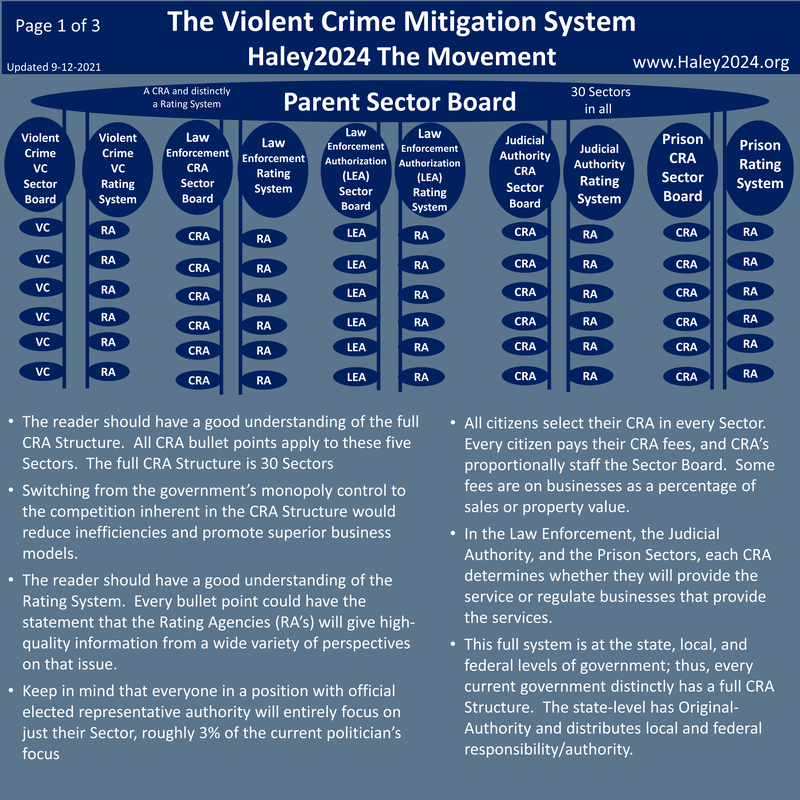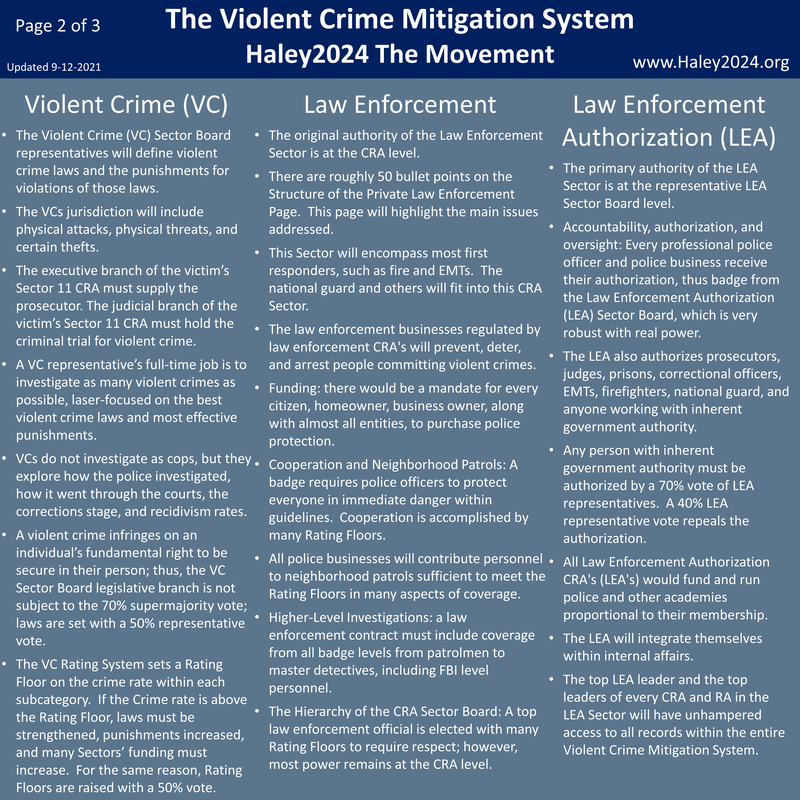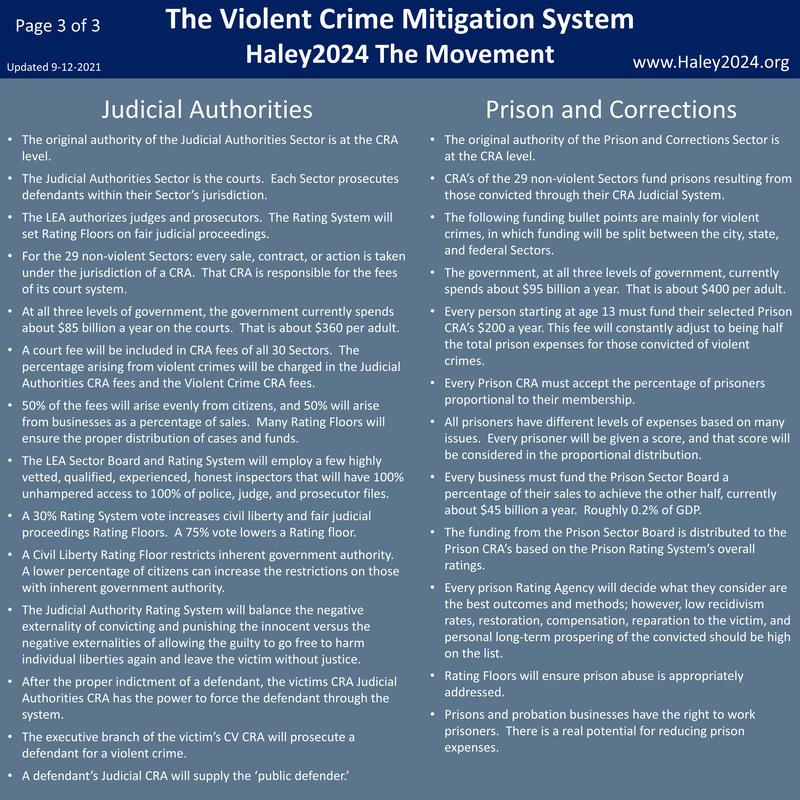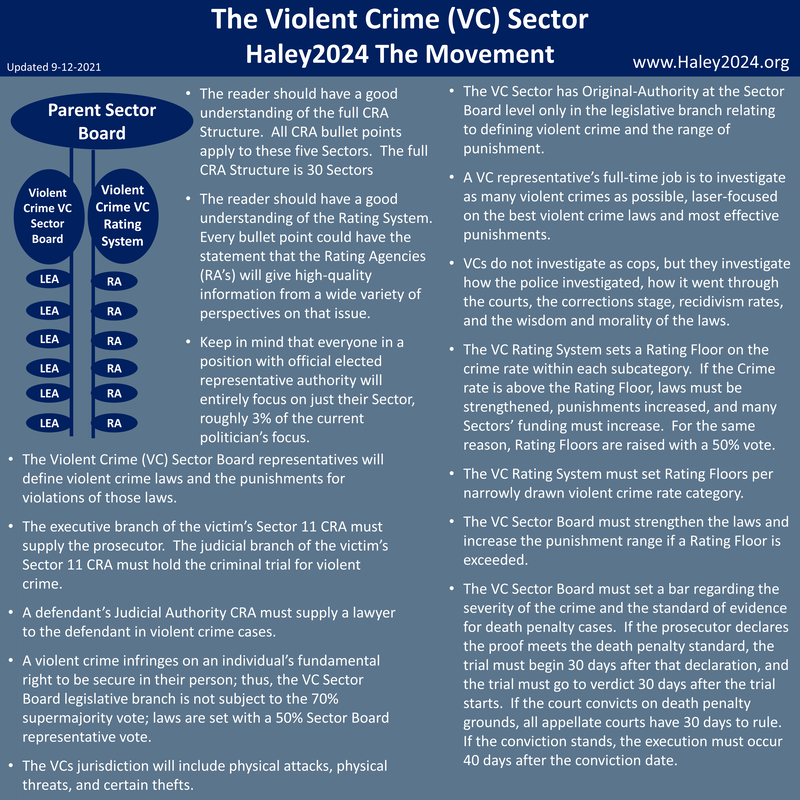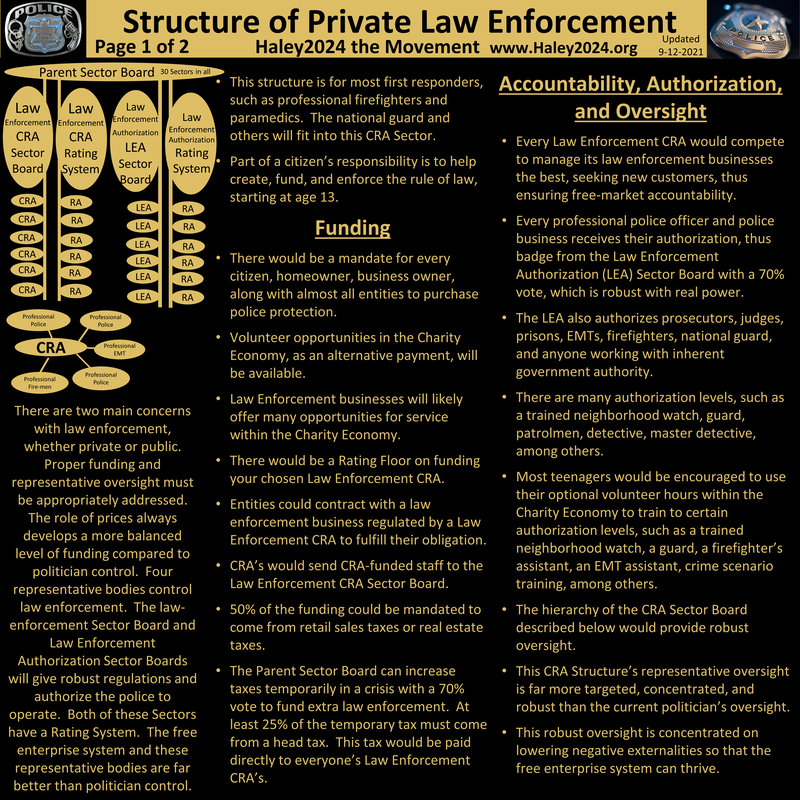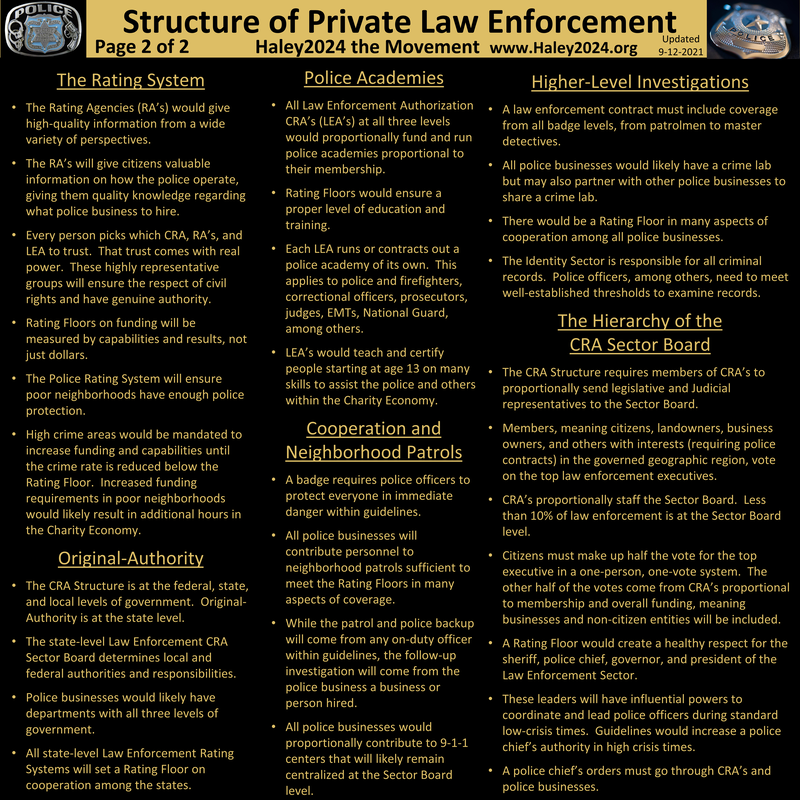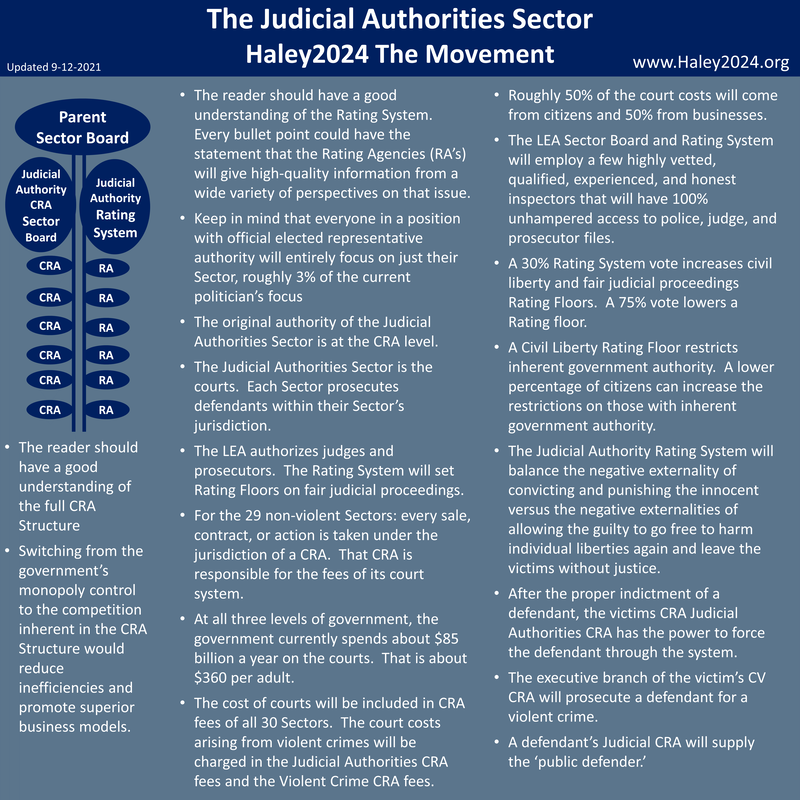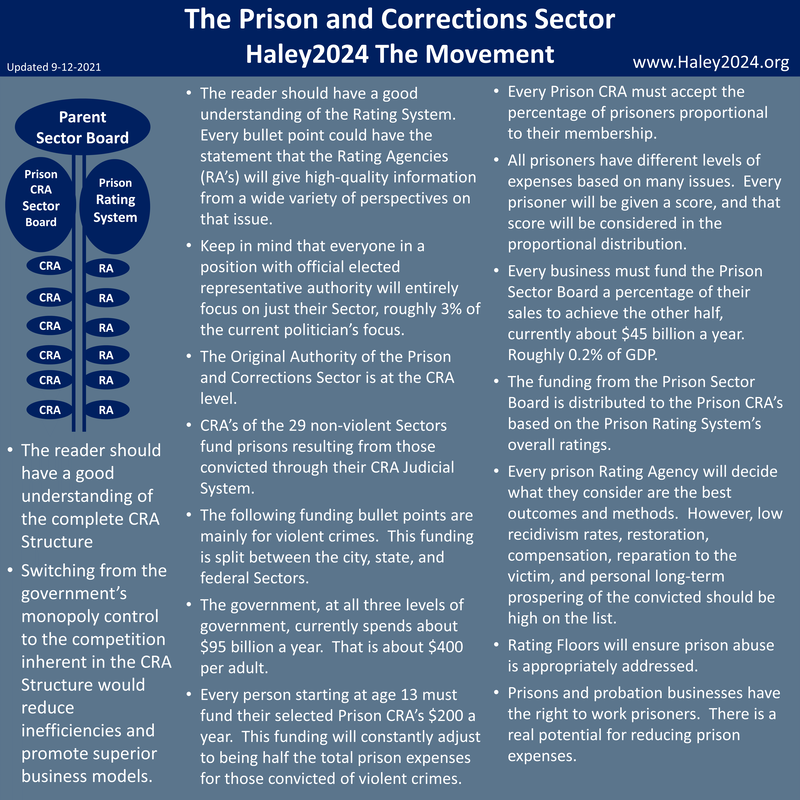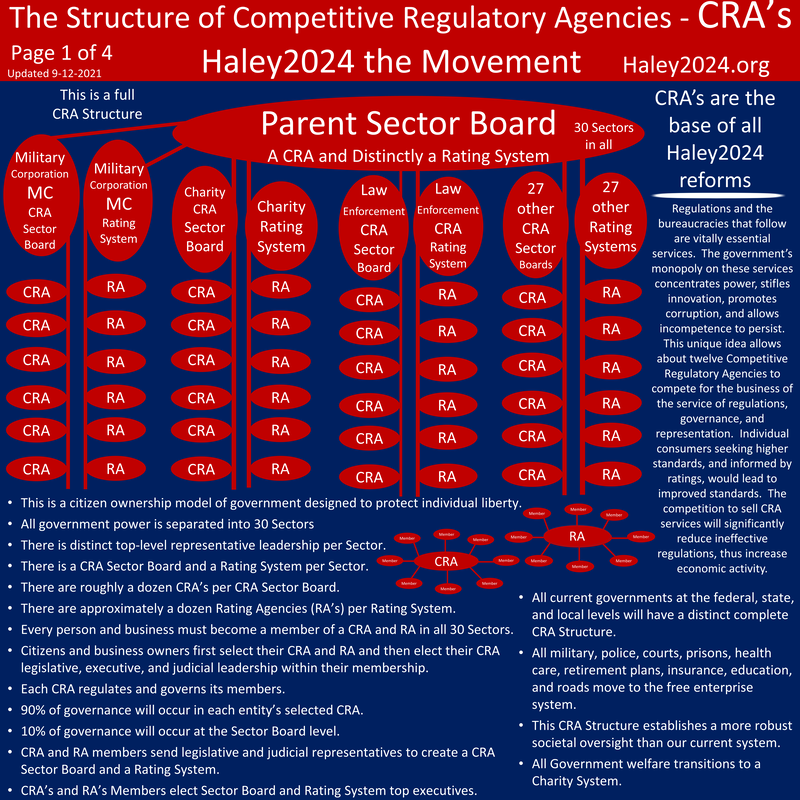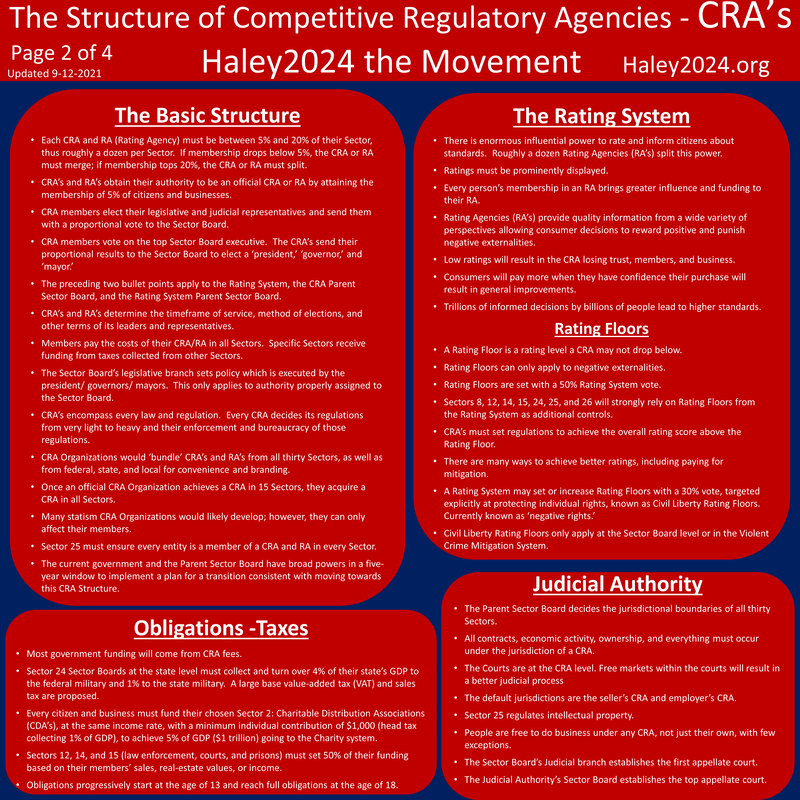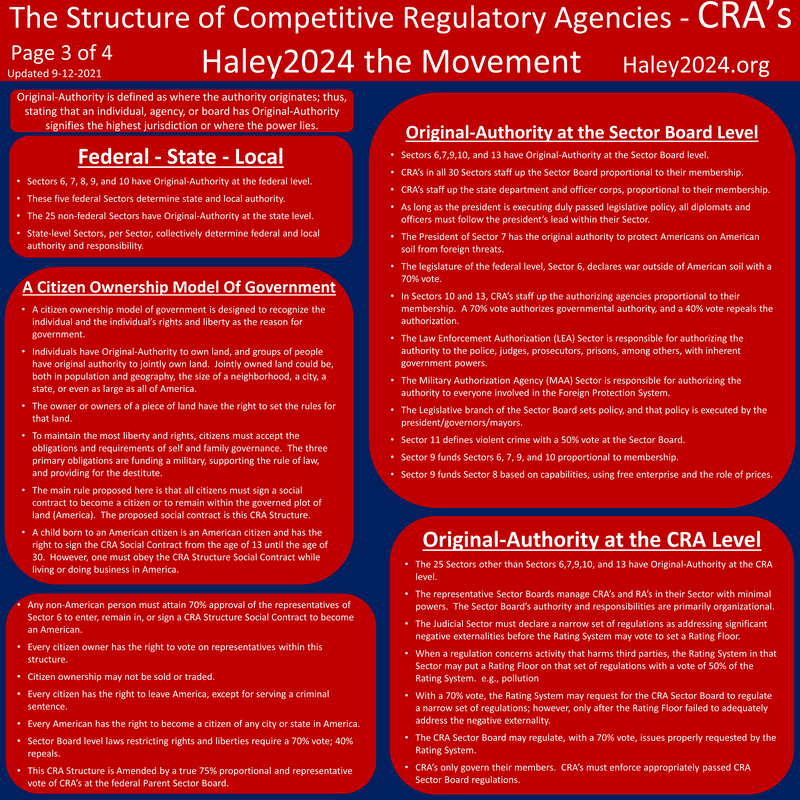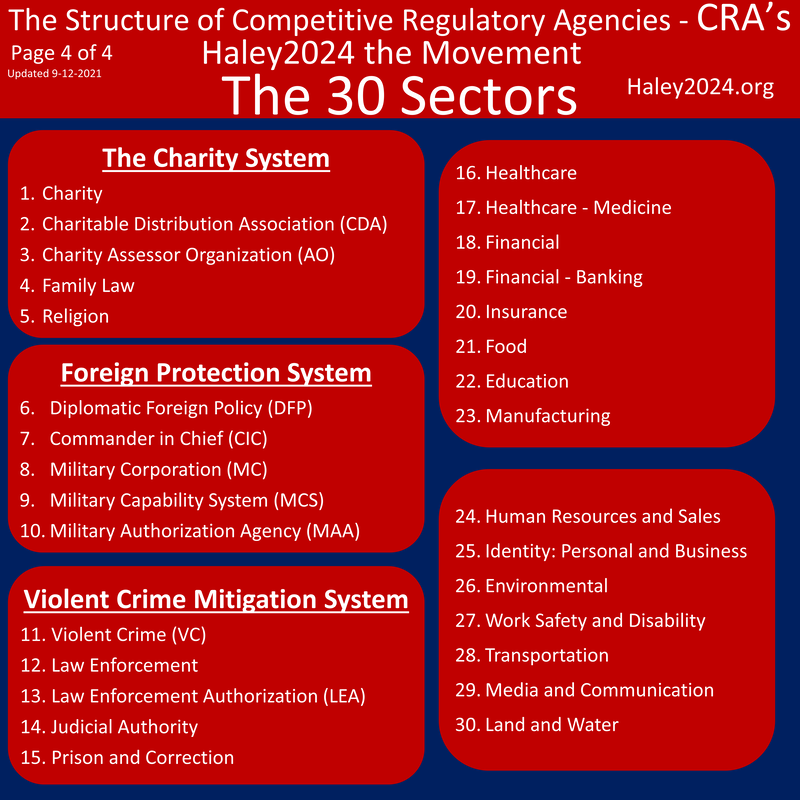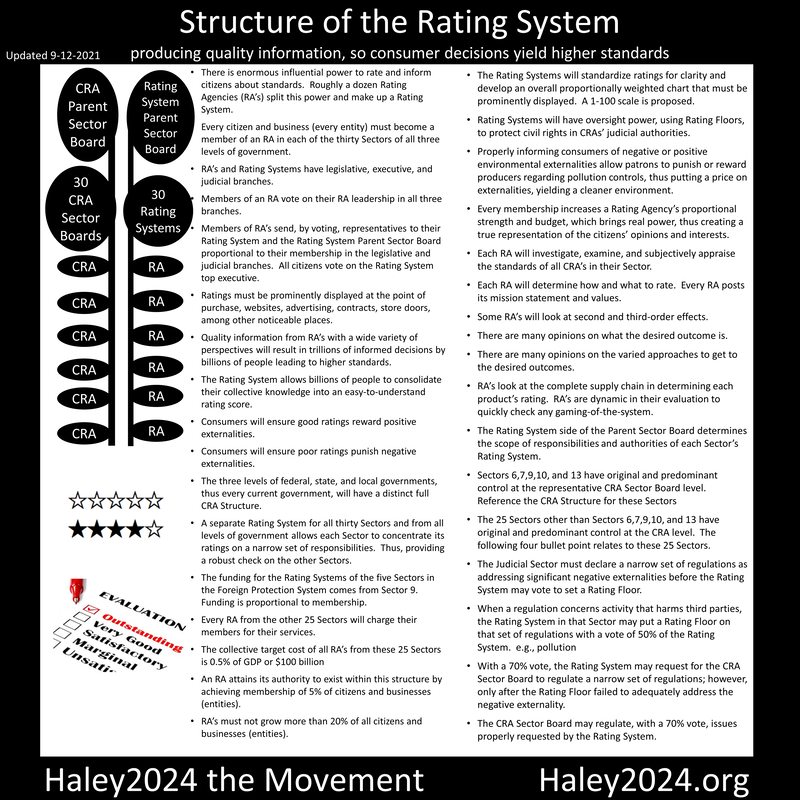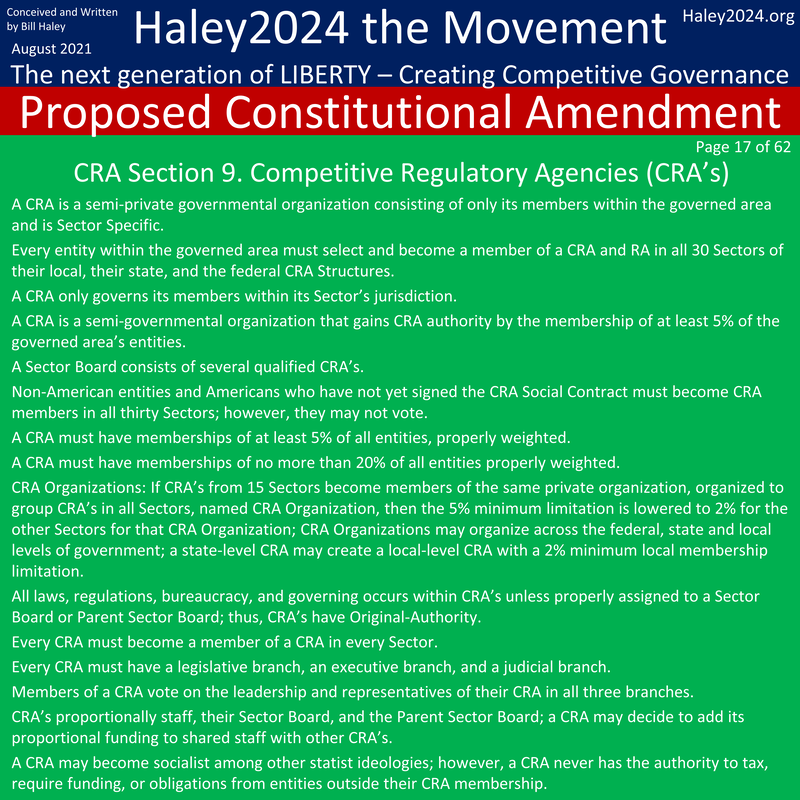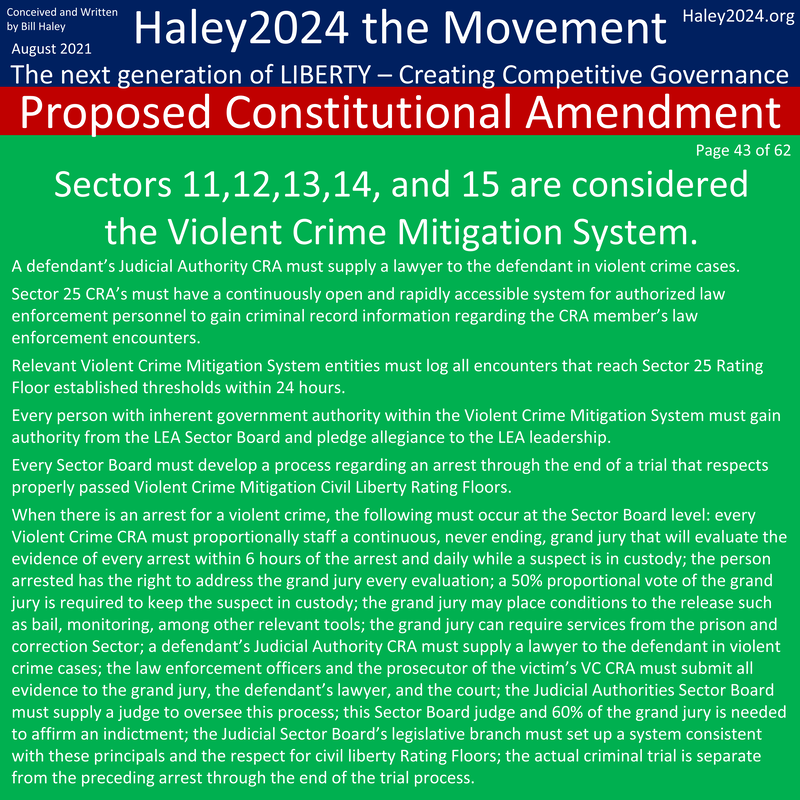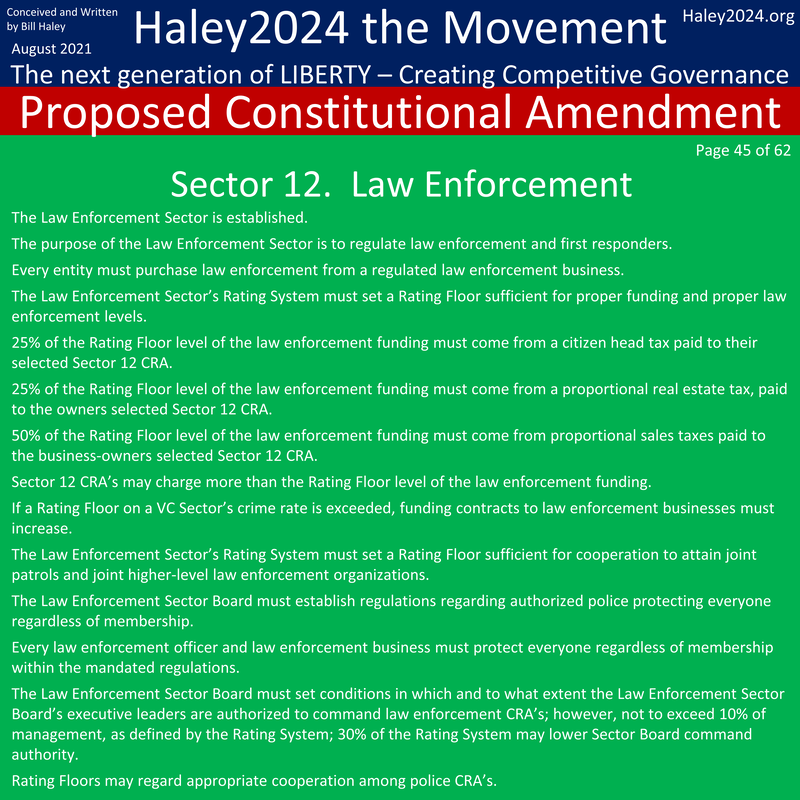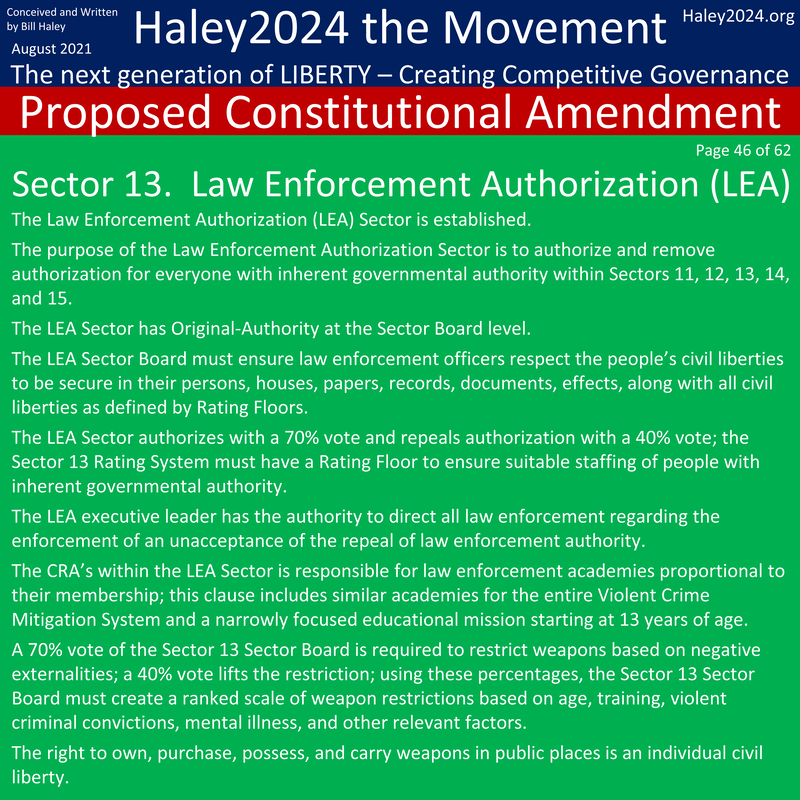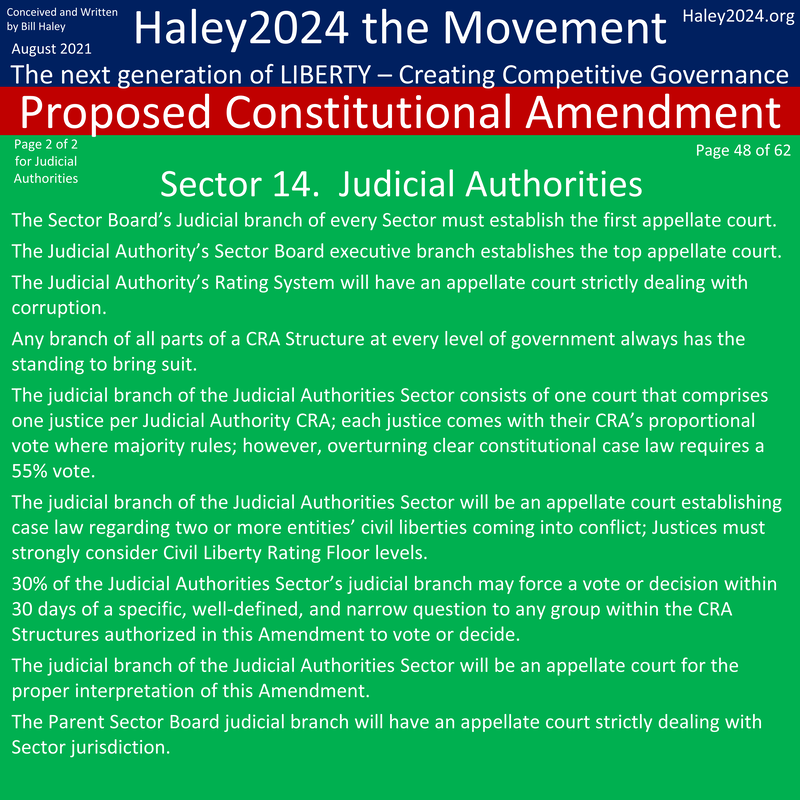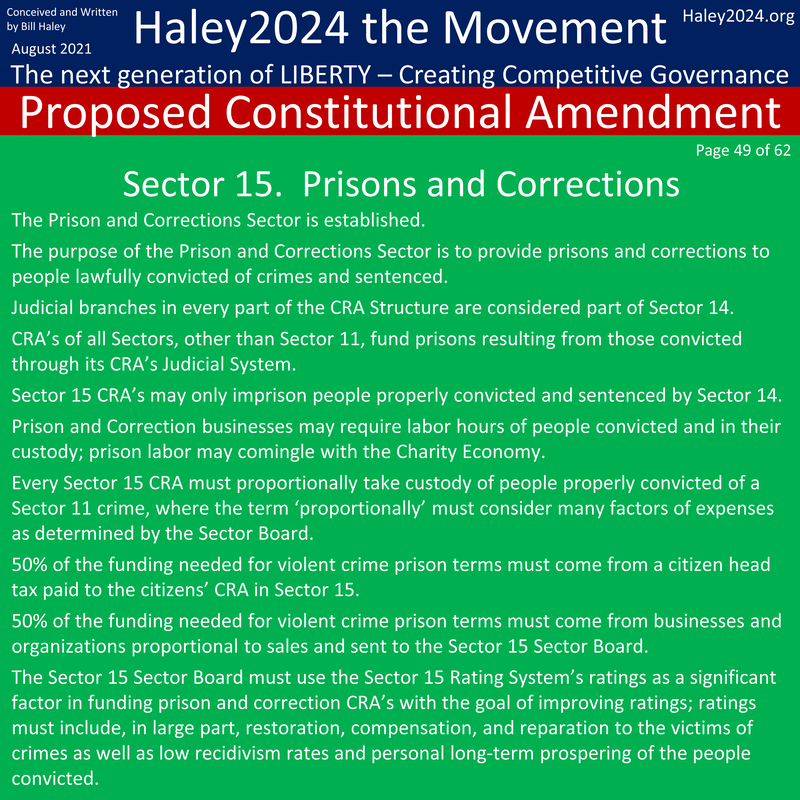The Structure of the Violent Crime Mitigation System
|
The Haley2024 reforms increase representative oversight. Ten separate representative bodies will use a division of labor and responsibilities to provide serious checks and balances to each other in the criminal justice system. Each agency will compete for every citizen’s business or trust. That business or trust brings real power to the business, CRA, or RA that attains the business, CRA, or trust. This division of labor and competition will lead to more expertise, attention, quality information, informed decisions, and better outcomes in all these areas of the violent criminal justice system.
|
|
|
|
|
Every citizen and business must belong to a CRA in all 30 Sectors of the CRA Structure. Since the people and businesses fund the business/CRA they are a member of, sufficient funding will be available. Trillions of decisions of billions of people will yield the right amount of funding. The Rating Systems have many overlapping interests, including adequate funding; therefore, funding decisions will be part of every rating and every transaction. Every Rating System has its responsibilities and direct concerns.
|
|
Violent crimes are assault and battery. These are crimes against a person. These will include physical attacks, threats, and certain thefts. All other crimes are within other Sectors. The Parent Sector Board decides the scope of authority for all thirty Sectors. The Violent Crime Sector Board’s original authority is at the representative Sector Board level. Everyone selects their VC and RA. The VC’s and RA’s proportionally send representatives to their respective sides of the Violent Crime Sector Board. The VC side decides what a violent crime is and the range of punishment for each violent crime. The judge and juries still do the sentencing.
|
|
Every VC and every RA should be a group of people with many years of experience in many areas of criminal law, that studies full-time, every case to see where they can improve. Citizens giving their trust to the VC and RA will not have to divide their vote of confidence with the concerns of all the other Sectors; the citizen’s full attention is on who best defines violent crime. Every citizen and every business owner will have representatives at their chosen VC Sector Board. City, state, and federal groups, with different proportional representations, will have some variation for their geographic region. City, state, and federal levels of government will all have well-defined areas of crime in which they are responsible.
|
|
|
|
|
Everyone must purchase law enforcement from one of many authorized law enforcement businesses. All police businesses will proportionally provide funding or manpower to neighborhood patrols. After an incident, a citizen’s police business will provide the detective services to solve crimes. Cooperation among all police businesses will likely yield better results, ratings, and cost-effectiveness.
|
|
There will be many police businesses competing for the business of police services for every person and business. The Rating System will be able to dig deep into every police business and study every aspect of how they do their business. Each Law Enforcement RA will decide what is important to them and report quality information. Everyone will have reports of about a dozen RA’s on every police business. Standards will rise when low rated police lose business to high rated police.
|
|
|
|
|
The Haley2024 goal is to move away from tax revenue to the greatest degree possible. In the blog, Disaster Relief in a Haley2024 World, there is expanded explanations of how the nature of all the Haley2024 reforms removes most of the government’s involvement. However, if the Parent Sector Board calls for additional funds from society for significant events, they could ask (Sector 24: Human Resources and sales) for those funds. Sector 24 is in charge of sales and income taxes. A 70% vote of the Parent Sector Board is required for additional taxes.
|
|
|
One of the significant issues that concern many about private police is that of insufficient funding for law-enforcement. One way around that issue is to mandate that every citizen and every business contract with police businesses. The Rating System will set a Rating Floor on ratings regarding how much police services every entity must have. The role of prices will allow billions of decisions by millions of people, decide the correct level of overall funding for law-enforcement. First responders will use a similar method.
|
|
One of the significant issues that concern many people about private police is that of representative oversight. Representatives of the people must give law enforcement officers, prosecutors, and anyone that has inherent power over others, that power. The LEA is mainly representative control. Every LEA sends representatives to the LEA Sector Board. These representatives determine the qualifications; however, the LEA is likely to include training, experience, good ratings, respecting civil liberties, among other factors. There will be many layers of authorizations, such as neighborhood guard, patrolmen, detective, and master detectives.
|
|
This reform allows every citizen to separately choose their representative in ten aspects of criminal law mitigation, including the LEA. The LEA Rating System is separate to give a division of power and for checks and balance purposes. Every citizen will choose their LEA’s RA representative agency that matches their philosophy. These RA’s will all independently decide what is important to rate. They will investigate with high levels of authority, law enforcement, and prosecutor’s practices and records.
|
|
|
|
|
The judicial system of the victim will prosecute a perpetrator of a violent crime. Every Judicial CRA will hire prosecutors, clerks, judges among others within the system. After the proper indictment of a perpetrator, the victim’s Judicial CRA affiliated organizations have the power to force the perpetrator through the system. The perpetrator calls on a lawyer to represent him or her, or the perpetrator’s judicial system will send the equivalent of a public defender.
|
|
The representative organization of LEA must give every person that holds a position of authority and power over others, that authority. Judges, prosecutors, prison guards, police, and other jobs with inherent societal authority must gain their authority from the LEA. The LEA ensures authority is matched with the proper level of responsibility and oversight. The LEA always retains the right to remove authority with a 40% LEA representative vote. Judges must have oversight. There are issues of extortion, corruption, bribery, incompetence, ideological incompatibility, among other topics. Highly vetted people from the Judicial Authorities Rating System will be able to dig deep to find concerns and, if necessary, remove the authorization to be a judge.
|
|
The LEA will authorize a few people that have the highest levels of trust, experience, honesty, among other positive features, to have unhampered access to all information. The police, judges, prosecutors, among others with power, often like to keep information close to the vest. The nature of the job frequently requires secrecy; however, because of their great power, oversight is necessary.
|
|
If a person is convicted and sentenced, there is a cost to imprisonment or probationary oversight, among other penalty options. State taxes will fund some of these options. The many experimentations of having the convict earn their keep will yield many low cost or free alternatives. The Prison CRA representatives will need to revisit funding options continuously as new and dynamic ways of doing corrections are advanced.
|
|
Every Prison Rating Agency will decide what they consider are the best outcomes and methods; however, low recidivism rates, restoration, compensation, reparation, and personal long-term prospering of the convicted should be high on the list. Prison and probation businesses/personnel also need oversight by the LEA. Rating Agencies will dig deep and by necessity rate dynamically. This Rating System will have all the tools to diminish prison abuse.
|
|
The financial incentive structure is the most essential factor in reducing cost, increasing productivity, decreasing abuse, and reducing inefficiency. Having prisons and probation businesses bid on convicted prisoners is only one part of the program. Extra funding for long-term results and better-rated companies is another. Current politicians do not have the time, experience, skill, or the results of experimentation to have the best correction system, and the results are not great. Every citizen choosing their representative for regulating and rating prisons and probation will allow those true representatives to give their full-time focus on creating the best system. Experimentation on many fronts and quality information on those experiments will yield ever-rising ratings and outcomes.
|


